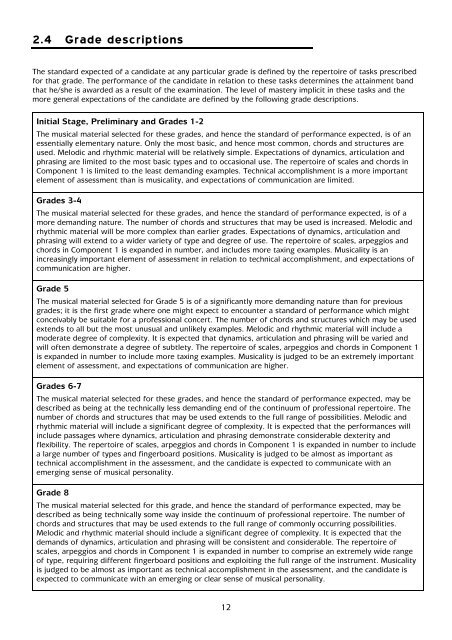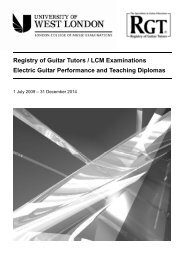LCM Exams / RGT: Acoustic Guitar Grades Syllabus - Registry of ...
LCM Exams / RGT: Acoustic Guitar Grades Syllabus - Registry of ...
LCM Exams / RGT: Acoustic Guitar Grades Syllabus - Registry of ...
You also want an ePaper? Increase the reach of your titles
YUMPU automatically turns print PDFs into web optimized ePapers that Google loves.
2.4 Grade descriptions<br />
The standard expected <strong>of</strong> a candidate at any particular grade is defined by the repertoire <strong>of</strong> tasks prescribed<br />
for that grade. The performance <strong>of</strong> the candidate in relation to these tasks determines the attainment band<br />
that he/she is awarded as a result <strong>of</strong> the examination. The level <strong>of</strong> mastery implicit in these tasks and the<br />
more general expectations <strong>of</strong> the candidate are defined by the following grade descriptions.<br />
Initial Stage, Preliminary and <strong>Grades</strong> 1-2<br />
The musical material selected for these grades, and hence the standard <strong>of</strong> performance expected, is <strong>of</strong> an<br />
essentially elementary nature. Only the most basic, and hence most common, chords and structures are<br />
used. Melodic and rhythmic material will be relatively simple. Expectations <strong>of</strong> dynamics, articulation and<br />
phrasing are limited to the most basic types and to occasional use. The repertoire <strong>of</strong> scales and chords in<br />
Component 1 is limited to the least demanding examples. Technical accomplishment is a more important<br />
element <strong>of</strong> assessment than is musicality, and expectations <strong>of</strong> communication are limited.<br />
<strong>Grades</strong> 3-4<br />
The musical material selected for these grades, and hence the standard <strong>of</strong> performance expected, is <strong>of</strong> a<br />
more demanding nature. The number <strong>of</strong> chords and structures that may be used is increased. Melodic and<br />
rhythmic material will be more complex than earlier grades. Expectations <strong>of</strong> dynamics, articulation and<br />
phrasing will extend to a wider variety <strong>of</strong> type and degree <strong>of</strong> use. The repertoire <strong>of</strong> scales, arpeggios and<br />
chords in Component 1 is expanded in number, and includes more taxing examples. Musicality is an<br />
increasingly important element <strong>of</strong> assessment in relation to technical accomplishment, and expectations <strong>of</strong><br />
communication are higher.<br />
Grade 5<br />
The musical material selected for Grade 5 is <strong>of</strong> a significantly more demanding nature than for previous<br />
grades; it is the first grade where one might expect to encounter a standard <strong>of</strong> performance which might<br />
conceivably be suitable for a pr<strong>of</strong>essional concert. The number <strong>of</strong> chords and structures which may be used<br />
extends to all but the most unusual and unlikely examples. Melodic and rhythmic material will include a<br />
moderate degree <strong>of</strong> complexity. It is expected that dynamics, articulation and phrasing will be varied and<br />
will <strong>of</strong>ten demonstrate a degree <strong>of</strong> subtlety. The repertoire <strong>of</strong> scales, arpeggios and chords in Component 1<br />
is expanded in number to include more taxing examples. Musicality is judged to be an extremely important<br />
element <strong>of</strong> assessment, and expectations <strong>of</strong> communication are higher.<br />
<strong>Grades</strong> 6-7<br />
The musical material selected for these grades, and hence the standard <strong>of</strong> performance expected, may be<br />
described as being at the technically less demanding end <strong>of</strong> the continuum <strong>of</strong> pr<strong>of</strong>essional repertoire. The<br />
number <strong>of</strong> chords and structures that may be used extends to the full range <strong>of</strong> possibilities. Melodic and<br />
rhythmic material will include a significant degree <strong>of</strong> complexity. It is expected that the performances will<br />
include passages where dynamics, articulation and phrasing demonstrate considerable dexterity and<br />
flexibility. The repertoire <strong>of</strong> scales, arpeggios and chords in Component 1 is expanded in number to include<br />
a large number <strong>of</strong> types and fingerboard positions. Musicality is judged to be almost as important as<br />
technical accomplishment in the assessment, and the candidate is expected to communicate with an<br />
emerging sense <strong>of</strong> musical personality.<br />
Grade 8<br />
The musical material selected for this grade, and hence the standard <strong>of</strong> performance expected, may be<br />
described as being technically some way inside the continuum <strong>of</strong> pr<strong>of</strong>essional repertoire. The number <strong>of</strong><br />
chords and structures that may be used extends to the full range <strong>of</strong> commonly occurring possibilities.<br />
Melodic and rhythmic material should include a significant degree <strong>of</strong> complexity. It is expected that the<br />
demands <strong>of</strong> dynamics, articulation and phrasing will be consistent and considerable. The repertoire <strong>of</strong><br />
scales, arpeggios and chords in Component 1 is expanded in number to comprise an extremely wide range<br />
<strong>of</strong> type, requiring different fingerboard positions and exploiting the full range <strong>of</strong> the instrument. Musicality<br />
is judged to be almost as important as technical accomplishment in the assessment, and the candidate is<br />
expected to communicate with an emerging or clear sense <strong>of</strong> musical personality.<br />
12



